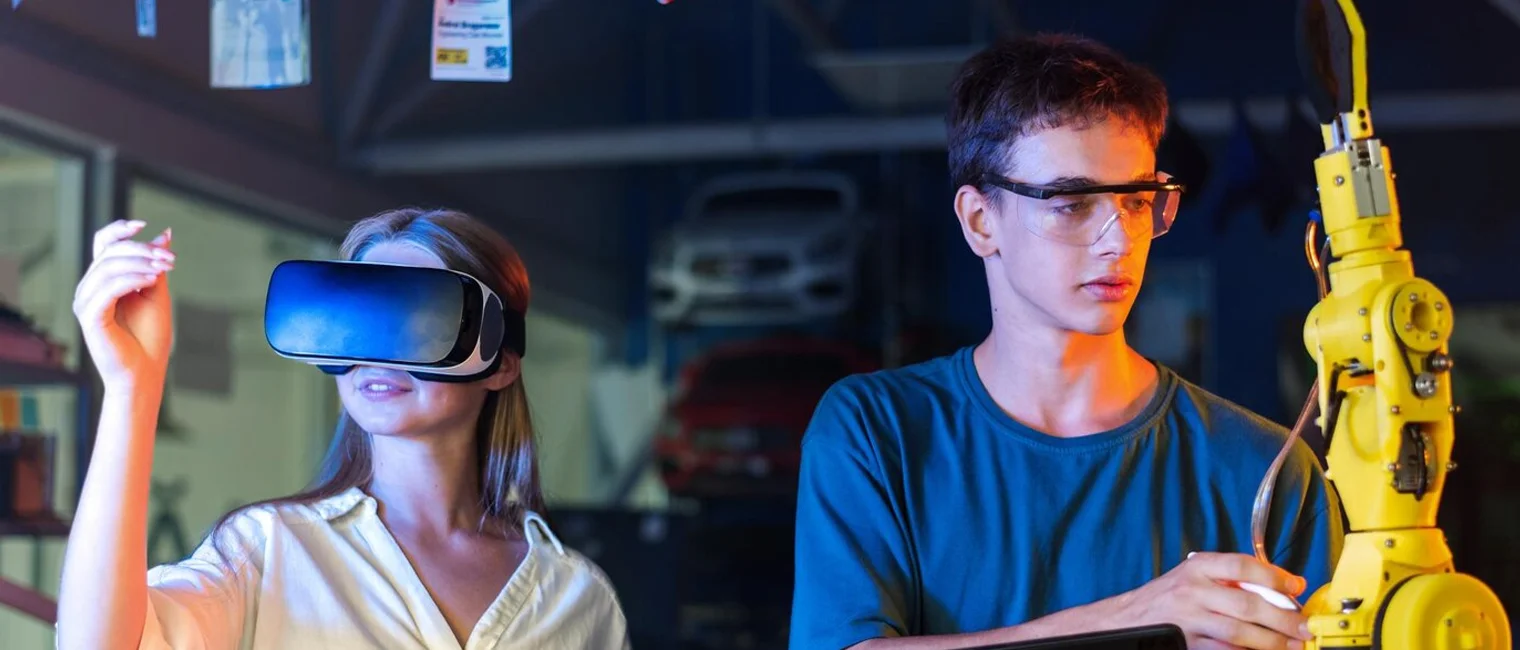VR Safety Training opens the door to a new era in occupational safety education. Virtual reality technology offers an interactive environment where risks are minimized, and experiential learning becomes a reality. Moving beyond traditional methods, this technology aims to enhance both the physical and mental preparedness of employees. Virtual reality makes training sessions more effective and engaging, ensuring that participants retain what they learn for longer periods. RoT STUDIO plays a pivotal role in the development and implementation of these training programs, offering tools that function like a “LEGO set” for virtual reality, enabling users to create immersive training experiences.
VR Safety Training is more than just a training tool—it is a strategic solution that strengthens a company’s safety culture. In critical scenarios such as working at heights, mining safety, or earthquake preparedness, employees can safely experience real-world situations in a controlled environment. The flexible and user-friendly platform provided by RoT STUDIO simplifies the creation of these training programs. With its no-code tools, users can easily customize training content to meet specific needs, ensuring that safety training is both effective and accessible.
What is a VR Training?
VR training refers to immersive learning experiences created using Virtual Reality (VR) technology, enabling users to engage with realistic simulations in a controlled virtual environment. This form of training is highly effective for industries that require hands-on practice, such as healthcare, manufacturing, aviation, and education. Through VR training, learners can practice skills, explore environments, or operate machinery without the risks or costs associated with real-world scenarios.
The key features of VR training include:
- Immersive Experience: Provides a sense of presence, making the training feel real.
- Interactivity: Enables active participation through simulated tasks or challenges.
- Repetition Without Risk: Allows trainees to repeat processes until mastery is achieved without real-world consequences.
- Performance Analytics: Tracks user performance, offering data-driven insights for improvement.
By leveraging VR technology, organizations can significantly enhance skill acquisition, improve knowledge retention, and increase overall training efficiency.
How Do You Create a VR Training?
Creating a VR training program involves several steps, combining technological expertise with an understanding of the training objectives. Here’s a step-by-step guide:
- Define Training Objectives: Clearly outline the goals of the training. For instance, is it to teach technical skills, enhance decision-making, or improve procedural understanding?
- Analyze the Target Audience: Identify who will use the VR training. This includes understanding their skill levels, roles, and specific learning needs.
- Design the Virtual Environment: Develop a realistic virtual setting that mimics the actual environment where the skills will be applied. Tools like Unity or Unreal Engine are commonly used for VR development.
- Create Interactive Scenarios: Incorporate tasks, challenges, and decision points to ensure active engagement. These scenarios should align with the training objectives and provide feedback on performance.
- Develop VR Content: Utilize 3D modeling, animation, and programming to create the VR experience. Collaboration with subject matter experts ensures accuracy and relevance.
- Test and Iterate: Conduct usability tests to identify and resolve issues. Feedback from initial users helps refine the experience.
- Implement and Monitor: Deploy the VR training and track its effectiveness through user performance analytics, surveys, or direct observation.
By following these steps, organizations can develop impactful VR training programs tailored to their unique needs, ensuring both effectiveness and scalability.
What are the Safety Standards for VR?
Safety standards for Virtual Reality (VR) are essential to ensure a secure and comfortable experience for users. These standards address physical, psychological, and technical aspects of VR usage, aiming to minimize risks and enhance the overall safety of immersive experiences. Below are key considerations for VR safety:
- Ergonomic Design
- Headset Comfort: VR headsets should be lightweight and adjustable to fit users of varying head sizes without causing strain.
- Controller Design: Handheld devices should be ergonomic and easy to use, reducing fatigue during extended sessions.
- Minimizing Physical Risks
- Clear Play Area: The VR play zone should be free of obstacles to avoid collisions or falls during movement.
- Protective Boundaries: Many VR systems include boundary warnings to alert users when they approach the edge of the play area.
- Health and Wellness
- Limiting Session Duration: Prolonged VR use can lead to eye strain or motion sickness. It is recommended to take breaks every 20-30 minutes.
- Addressing Cybersickness: Developers should optimize VR content to reduce lag, improve frame rates, and minimize disorienting visual effects.
- Content Safety
- Age-Appropriate Content: VR experiences should align with age ratings to avoid exposing users, particularly children, to inappropriate or harmful content.
- Psychological Safety: Intense or disturbing simulations should include warnings to prepare users for potentially triggering content.
- Technical Standards
- Device Calibration: Proper calibration ensures accuracy in motion tracking and prevents misalignment issues.
- Data Privacy and Security: VR devices must adhere to data protection regulations, ensuring user data is collected, stored, and used responsibly.
- Compliance with Industry Guidelines
- VR devices and applications should meet established safety standards, such as those outlined by organizations like ISO (International Organization for Standardization) or IEEE (Institute of Electrical and Electronics Engineers).
By adhering to these safety standards, VR developers and users can create a safer and more enjoyable experience while minimizing the risks associated with immersive technology.

VR Safety Training Solutions
VR Safety Training Solutions introduces a transformative approach to workplace safety, utilizing immersive virtual reality experiences to prepare employees for real-world challenges. Traditional safety training methods, while valuable, often fail to provide the hands-on experience necessary for workers to fully grasp the complexities of potential hazards. This is where virtual reality bridges the gap, creating lifelike scenarios in a controlled and safe environment.
At RoT STUDIO, we understand the critical importance of practical and effective safety training. Our platform empowers organizations to design and deploy VR-based training modules tailored to their unique needs. With tools that require no coding expertise, training professionals can effortlessly create scenarios covering diverse safety concerns such as:
- Working at Heights: Simulate high-risk scenarios, allowing employees to practice safety protocols without real-world exposure.
- Underground Mining Risk Training: Immerse workers in virtual mine environments to identify hazards and rehearse emergency procedures.
- Earthquake Preparedness: Provide employees with step-by-step guidance on how to respond effectively during seismic events.
The versatility of VR Safety Training Solutions extends across industries, ensuring that companies can address specific challenges while enhancing overall workplace safety. By leveraging RoT STUDIO’s innovative tools, organizations can not only minimize risks but also foster a culture of safety, equipping their workforce with the skills and confidence to navigate hazardous environments.
RoT STUDIO’s platform further supports real-time feedback and analytics, enabling trainers to identify areas for improvement and optimize their programs. This dynamic approach to safety training ensures that learning outcomes are both measurable and impactful, laying the foundation for a safer workplace.
VR Safety Training Cost
The cost of implementing VR safety training solutions depends on various factors, including the level of customization, the scope of deployment, and the hardware and software requirements. Below is a breakdown of potential cost components:
- Development and Customization
- Pre-Made Modules: More affordable, ready-to-use modules for common safety scenarios.
- Custom-Built Scenarios: Higher costs associated with creating industry-specific or organization-specific training environments.
- Hardware Costs
- VR Headsets: Devices like Meta Quest, HTC Vive, or other enterprise-grade headsets vary in price depending on their capabilities.
- Compatible Computers: High-performance systems may be necessary to support complex VR simulations.
- Software Licensing
- Training Platforms: Subscription-based VR training platforms may charge monthly or yearly fees.
- Content Updates: Additional fees for updating or expanding training content as regulations and needs evolve.
- Scalability
- User Licenses: Costs often increase based on the number of employees or trainees.
- Multi-Device Deployment: Larger-scale deployments may require more equipment, driving up expenses.
- Additional Services
- Training Support: Onboarding and ongoing technical support might incur additional charges.
- Analytics and Reporting: Advanced data tracking and reporting features could add to the overall cost.
Cost Efficiency Over Time:
Although the upfront investment in VR safety training can be significant, it is often offset by long-term savings in areas such as:
- Reduced Incident Costs: Fewer workplace accidents lower medical and compensation expenses.
- Operational Efficiency: Faster onboarding and training cycles save time and resources.
- Improved Compliance: Minimizes penalties or fines associated with safety violations.
Organizations can choose from a variety of options, ranging from cost-effective pre-built solutions to fully customized packages, ensuring a balance between quality and budget.

VR Construction Safety Training
VR construction safety training is a cutting-edge solution designed to enhance safety awareness and preparedness in the construction industry. This training method uses Virtual Reality (VR) technology to simulate real-life construction site scenarios, providing workers with immersive, hands-on experiences to learn safety protocols effectively and efficiently.
Key Features of VR Construction Safety Training:
- Realistic Site Simulations: Recreates construction site environments with potential hazards such as falling objects, machinery operation, and confined spaces.
- Interactive Scenarios: Allows trainees to engage with safety procedures, such as wearing protective equipment or responding to emergencies.
- Customizable Modules: Tailors training content to specific projects, site conditions, or compliance requirements.
- Risk-Free Practice: Enables users to learn and make mistakes in a safe virtual setting without real-world consequences.
- Instant Feedback: Provides immediate evaluations of trainees’ performance, highlighting areas for improvement.
Benefits of VR Construction Safety Training:
- Enhanced Safety Awareness: Workers gain a deeper understanding of potential risks and how to mitigate them.
- Improved Skill Retention: Immersive training techniques lead to better long-term retention of safety practices.
- Reduced Workplace Accidents: Prepares employees to handle hazardous situations effectively, minimizing on-site incidents.
- Cost-Effective Training: Reduces the need for physical resources, travel, and equipment, lowering overall training expenses.
- Regulatory Compliance: Ensures adherence to industry safety standards and guidelines.
Common Scenarios in VR Construction Safety Training:
- Working at heights and fall protection.
- Safe operation of heavy machinery and tools.
- Identifying and addressing electrical hazards.
- Emergency evacuation procedures.
- Proper use of personal protective equipment (PPE).
By implementing VR construction safety training, companies can significantly improve worker safety, boost productivity, and foster a culture of vigilance on construction sites. This innovative approach equips employees with the skills they need to navigate the complexities of construction work safely and confidently.

